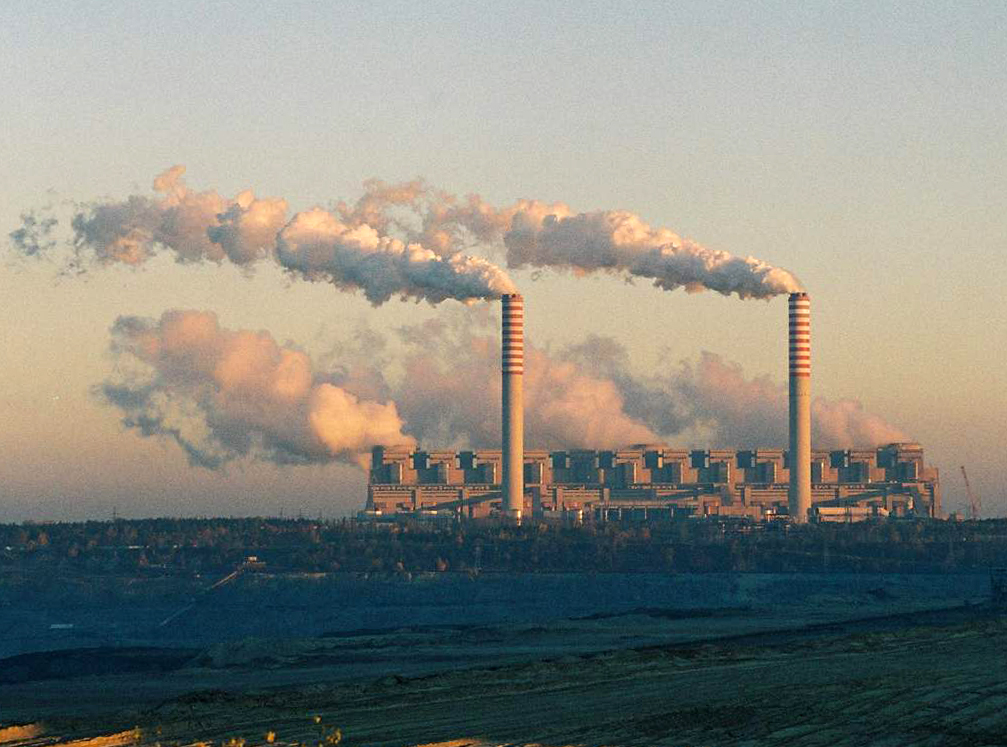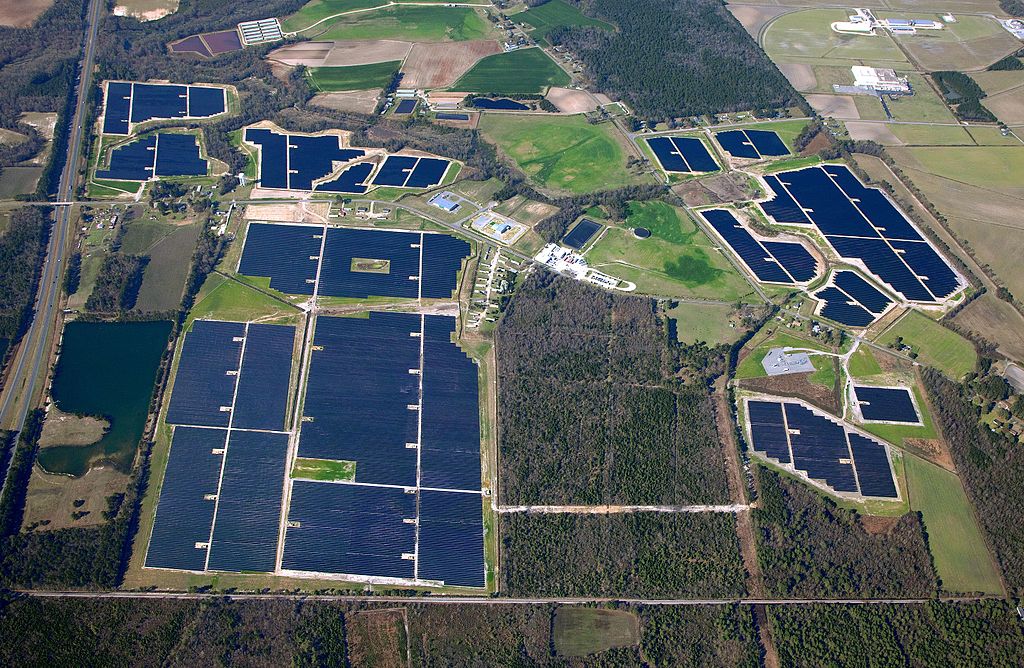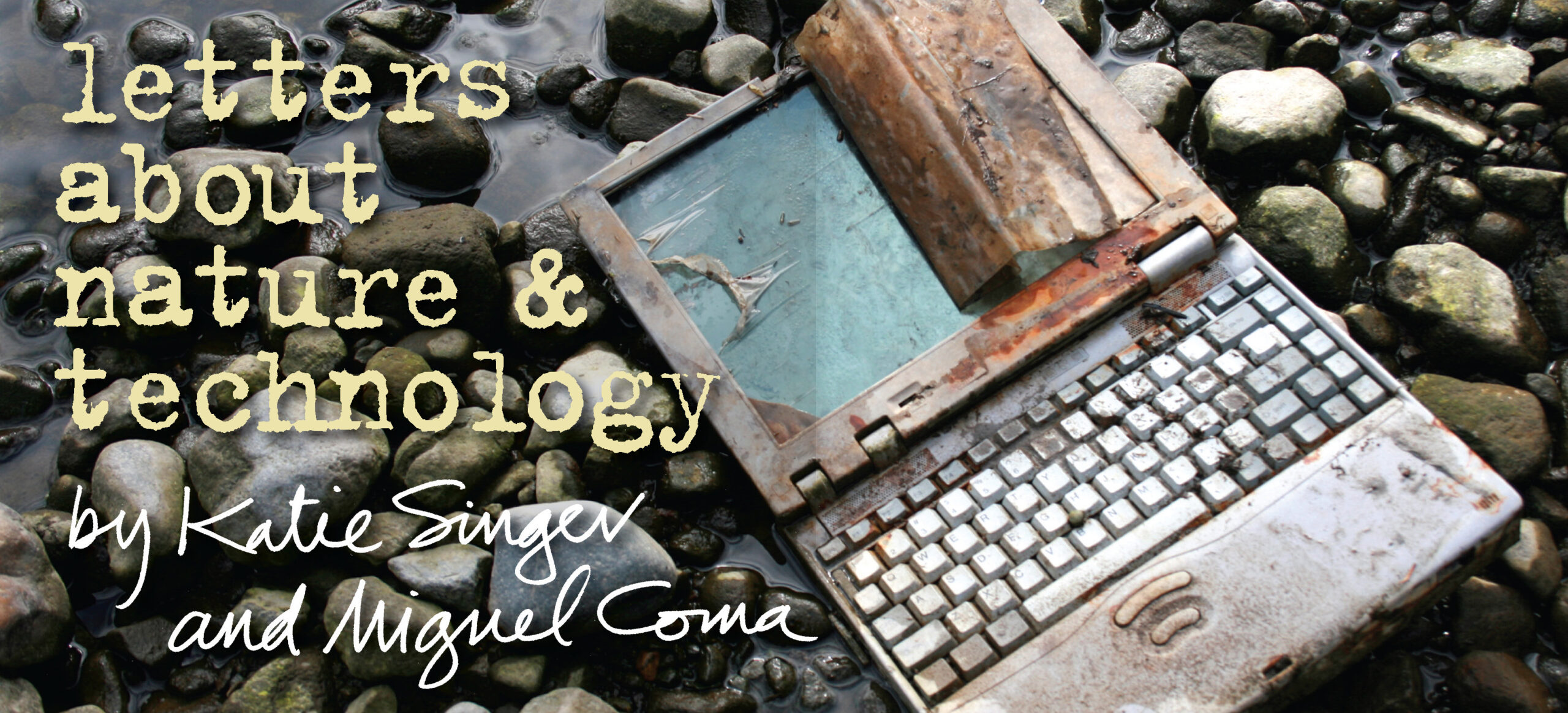Re-Evaluating Solar Photovoltaic Power
Considering the ecological impacts we aim to reduce
by Katie Singer
Even when reality is harsh, I prefer it. I’d rather engineers say that my water could be off for three hours than tell me that replacing the valve will take one hour. I prefer knowing whether or not tomatoes come from genetically modified seed. If dyeing denim wreaks ecological hazards, I’d rather not keep ignorant.
The illusion that we’re doing good when we’re actually causing harm is not constructive. With reality, discovering true solutions becomes possible.
As extreme weather events (caused, at least in part, by fossil fuels’ greenhouse gas [GHG] emissions) challenge electrical infrastructures, we need due diligent evaluations that help us adapt to increasingly unpredictable situations—and drastically reduce greenhouse gas emissions and ecological damage. I have a hard time imagining a future without electricity, refrigerators, stoves, washing machines, phones and vehicles. I also know that producing and disposing of manufactured goods ravages the Earth.
Internationally, governments are investing in solar photovoltaics (PVs) because they promise less ecological impacts than other fuel sources. First, I vote for reviewing aspects of solar systems that tend to be overlooked.

Coal-fired power plants commonly provide electricity to smelt silicon for solar panels. Photo credit: Petr Štefek
Hazards of Solar Photovoltaic Power
1. Manufacturing silicon wafers for solar panels depends on fossil fuels, nuclear and/or hydro power. Neither solar nor wind energy can power a smelter, because interrupted delivery of electricity can cause explosions at the factory. Solar PV panels’ silicon wafers are “one of the most highly refined artifacts ever created.”[1] Manufacturing silicon wafers starts with mining quartz; pure carbon (i.e. petroleum coke [an oil byproduct] or charcoal from burning trees without oxygen); and harvesting hard, dense wood, then transporting these substances, often internationally, to a smelter that is kept at 3000F (1648C) for years at a time. Typically, smelters are powered by electricity generated by a combination of coal, natural gas, nuclear and hydro power. The first step in refining the quartz produces metallurgical grade silicon. Manufacturing solar-grade silicon (with only one impurity per million) requires several other energy-intensive, greenhouse gas (GHG) and toxic waste-emitting steps. [2] [3] [4]
2. Manufacturing silicon wafers generates toxic emissions
In 2016, New York State’s Department of Environmental Conservation issued Globe Metallurgical Inc. a permit to release, per year: up to 250 tons of carbon monoxide, 10 tons of formaldehyde, 10 tons of hydrogen chloride, 10 tons of lead, 75,000 tons of oxides of nitrogen, 75,000 tons of particulates, 10 tons of polycyclic aromatic hydrocarbons, 40 tons of sulfur dioxide and up to 7 tons of sulfuric acid mist. To clarify, this is the permittable amount of toxins allowed annually for one metallurgical-grade silicon smelter in New York State. [5] Hazardous emissions generated by silicon manufacturing in China (the world’s leading manufacturer of solar PVs) likely has significantly less regulatory limits.
3. PV panels’ coating is toxic
PV panels are coated with fluorinated polymers, a kind of Teflon. Teflon films for PV modules contain polytetrafluoroethylene (PTFE) and fluorinated ethylene (FEP). When these chemicals get into drinking water, farming water, food packaging and other common materials, people become exposed. About 97% of Americans have per- and polyfluoroalkyl substances (PFAs) in their blood. These chemicals do not break down in the environment or in the human body, and they can accumulate over time. [6] [7] While the long-term health effects of exposure to PFAs are unknown, studies submitted to the EPA by DuPont (which manufactures them) from 2006 to 2013 show that they caused tumors and reproductive problems in lab animals. Perfluorinated chemicals also increase risk of testicular and kidney cancers, ulcerative colitis (Crohn’s disease), thyroid disease, pregnancy-induced hypertension (pre-eclampsia) and elevated cholesterol. How much PTFEs are used in solar panels? How much leaks during routine operation—and when hailstorms (for example) break a panels’ glass? How much PTFE leaks from panels discarded in landfills? How little PFA is needed to impact health?
4. Manufacturing solar panels generates toxic waste. In California, between 2007 and the first half of 2011, seventeen of the state’s 44 solar-cell manufacturing facilities produced 46.5 million pounds of sludge (semi-solid waste) and contaminated water. California’s hazardous waste facilities received about 97 percent of this waste; more than 1.4 million pounds were transported to facilities in nine other states, adding to solar cells’ carbon footprint. [8]
5. Solar PV panels can disrupt aquatic insects’ reproduction. At least 300 species of aquatic insects (i.e. mayflies, caddis flies, beetles and stoneflies) typically lay their eggs on the surface of water. Birds, frogs and fish rely on these aquatic insects for food. Aquatic insects can mistake solar panels’ shiny dark surfaces for water. When they mate on panels, the insects become vulnerable to predators. When they lay their eggs on the panels’ surface, their efforts to reproduce fail. Covering panels with stripes of white tape or similar markings significantly reduces insect attraction to panels. Such markings can reduce panels’ energy collection by about 1.8 percent. Researchers also recommend not installing solar panels near bodies of water or in the desert, where water is scarce. [9]

Solar PV users may be unaware of their system’s ecological impacts. Photo credit: Vivint Solar from Pexels
6. Unless solar PV users have battery backup (unless they’re off-grid), utilities are obliged to provide them with on-demand power at night and on cloudy days. Most of a utility’s expenses are dedicated not to fuel, but to maintaining infrastructure—substations, power lines, transformers, meters and professional engineers who monitor voltage control and who constantly balance supply of and demand for power. [10] Excess power reserves will increase the frequency of alternating current. When the current’s frequency speeds up, a motor’s timing can be thrown off. Manufacturing systems and household electronics can have shortened life or fail catastrophically. Inadequate reserves of power can result in outages.
The utility’s generator provides a kind of buffer to its power supply and its demands. Rooftop solar systems do not have a buffer.
In California, where grid-dependent rooftop solar has proliferated, utilities sometimes pay nearby states to take their excess power in order to prevent speeding up of their systems’ frequency. [11]
Rooftop solar (and wind turbine) systems have not reduced fossil-fuel-powered utilities. In France, from 2002-2019, while electricity consumption remained stable, a strong increase in solar and wind powered energy (over 100 GW) did not reduce the capacity of power plants fueled by coal, gas, nuclear and hydro. [12]
Comparing GHG emissions generated by different fuel sources shows that solar PV is better than gas and coal, but much worse than nuclear and wind power. A solar PV system’s use of batteries increases total emissions dramatically. Compared to nuclear or fossil fuel plants, PV has little “energy return on energy Invested.” [13]
7. Going off-grid requires batteries, which are toxic. Lead-acid batteries are the least expensive option; they also have a short life and lower depth of discharge (capacity) than other options. Lead is a potent neurotoxin that causes irreparable harm to children’s brains. Internationally, because of discarded lead-acid batteries, one in three children have dangerous lead levels in their blood. [14] Lithium-ion batteries have a longer lifespan and capacity compared to lead acid batteries. However, lithium processing takes water from farmers and poisons waterways. [15] Lithium-ion batteries are expensive and toxic when discarded. Saltwater batteries do not contain heavy metals and can be recycled easily. However, they are relatively untested and not currently manufactured.
8. Huge solar arrays require huge battery electric storage systems (BESS). A $150 million battery storage system can provide 100 MW for, at most, one hour and eighteen minutes. This cannot replace large-scale delivery of electricity. Then, since BESS lithium-ion batteries must be kept cool in summer and warm in winter, they need large heating, ventilation, air conditioning (HVAC) systems. (If the Li-ion battery overheats, the results are catastrophic.) Further, like other batteries, they lose their storage capacity over time and must be replaced—resulting in more extraction, energy and water use, and toxic waste. [16]
9. Solar PV systems cannot sufficiently power energy guzzlers like data centers, access networks, smelters, factories or electric vehicle [EV] charging stations. If French drivers shifted entirely to EVs, the country’s electricity demands would double. To produce this much electricity with low-carbon emissions, new nuclear plants would be the only option. [17] In 2007, Google boldly aimed to develop renewable energy that would generate electricity more cheaply than coal-fired plants can in order to “stave off catastrophic climate change.” Google shut down this initiative in 2011 when their engineers realized that “even if Google and others had led the way toward a wholesale adaptation of renewable energy, that switch would not have resulted in significant reductions of carbon dioxide emissions…. Worldwide, there is no level of investment in renewables that could prevent global warming.” [18]
10. Solar arrays impact farming. When we cover land with solar arrays and wind turbines, we lose plants that can feed us and sequester carbon. [19]
11. Solar PV systems’ inverters “chop” current and cause “dirty” power, which can impact residents’ health. [20]
12. At the end of their usable life, PV panels are hazardous waste. The toxic chemicals in solar panels include cadmium telluride, copper indium selenide, cadmium gallium (di)selenide, copper indium gallium (di)selenide, hexafluoroethane, lead, and polyvinyl fluoride. Silicon tetrachloride, a byproduct of producing crystalline silicon, is also highly toxic. In 2016, The International Renewable Energy Agency (IRENA) estimated that the world had 250,000 metric tons of solar panel waste that year; and by 2050, the amount could reach 78 million metric tons. The Electric Power Research Institute recommends not disposing of solar panels in regular landfills: if modules break, their toxic materials could leach into soil. [21] In short, solar panels do not biodegrade and are difficult to recycle.
To make solar cells more recyclable, Belgian researchers recommend replacing silver contacts with copper ones, reducing the silicon wafers’ (and panels’) thickness, and removing lead from the panels’ electrical connections. [22]

Aerial view of a solar farm. Photo credit: Dsink000
13. Solar farms warm the Earth’s atmosphere.
Only 15% of sunlight absorbed by solar panels becomes electricity; 85% returns to the environment as heat. Re-emitted heat from large-scale solar farms affects regional and global temperatures. Scientists’ modeling shows that covering 20% of the Sahara with solar farms (to power Europe) would raise local desert temperatures by 1.5°C (2.7°F). By covering 50% of the Sahara, the desert’s temperature would increase by 2.5°C (4.5°F). Global temperatures would increase as much as 0.39°C—with polar regions warming more than the tropics, increasing loss of Arctic Sea ice. [23] As governments create “green new deals,” how should they use this modeling?
Other areas need consideration here: dust and dirt that accumulate on panels decreases their efficiency; washing them uses water that might otherwise go to farming. Further, Saharan dust, transported by wind, provides vital nutrients to the Amazon’s plants and the Atlantic Ocean. Solar farms on the Sahara could have other global consequences. [24]
14. Solar PV users may believe that they generate “zero-emitting,” “clean” power without awareness of the GHGs, extractions, smelting, chemicals and cargo shipping involved in manufacturing such systems—or the impacts of their disposal. If our only hope is to live with much less human impact to ecosystems, then how/could we decrease solar PVs’ impacts? Could we stop calling solar PV power systems “green” and “carbon-neutral?” If not, why not?
Facebook responses
I posted this article on Facebook, March 3rd.. Here are some of the exchanges I had with readers:
Q: If solar has so many hazards, what should I spend my money on?
KS: I LOVE your question: What should I spend my money on? May many more people and governments ask this question.
I dream that money can go to every household getting at least two raised planting beds with nutrient-dense soil and insulating covers–so we could grow more of our food. Industrial agriculture has taken that skill from so many of us; industrial ag also guzzles energy. #2, I’d welcome educational forums so that people could discuss your question. We could respectfully ask, What’s essential? What’s a luxury? What’s within our ecological means?
Please note: In some cases, I can see that solar PV power is of great benefit. Also, the points I raise about solar’s ecological hazards are worthy of respectful discussion. I don’t consider solar a one-size fits all solution.
Q: Can’t smelters be powered by renewables?
KS: As I understand, most silicon is smelted in China, where regulations are limited or non-existent. I personally know a man whose “socially-conscious” investment firm bought a silicon smelter; and it comes with not one, but TWO coal-fired power plants to ensure that power to the smelter will not be interrupted. In Iceland, United Silicon, in Helguvik, has significantly increased the amount of coal that the country burns. In the U.S., the German company, Wacker, opened a silicon smelter in Tennessee in 2016; it’s powered by a combination of coal, nuclear and hydro power. I know of other examples like these. I do not know of a smelter powered by solar or wind power.
Q: Despite its hazards, isn’t solar power still better than fossil fuels?
KS: My focus is not on quantifying whether solar is more or less harmful than other fuel sources. My point is that it does have ecological impacts. If we look at solar from its cradle-to-cradle, it’s not pure and clean, not carbon-neutral. It’s not zero-emitting. We do ourselves a disservice when we ignore its ecological impacts…and when we ignore that it’s not able to power industrial processes like smelting.
For the record, I am no fan of nuclear power. During routine operations, they leak electromagnetic radiation, and children nearby have higher rates of leukemia. Further, manufacturing all that cement generates equal or greater amounts of CO2. I advocate for substantial degrowth among those of us who have clean water, indoor plumbing, nutrient-dense food and basic electricity. Instead of manufacturing e-vehicles (for example), we need to quit the individually owned vehicle altogether. With solar power, are we aiming to continue current lifestyle levels? Can we recognize that solar power has ecological impacts, that it’s not a cure-all? Could we give attention to reducing production and consumption…or do we just rest with the idea that solar is our solution?
Coilín ÓhAiseadha (a scientist who’s published peer-reviewed papers comparing fuel sources): It is not practicable for solar power to provide enough energy for a large industrial nation to power its factories, water treatment plants, hospitals, mass transit systems. Two reasons:
- Intermittency, i.e., no solar power at night. This is not easily solved by energy storage at utility scale, except where pumped hydroelectric storage can easily be constructed.
- Power density, i.e., the fact that utility-scale solar power requires vast land areas.
The solutions are technically conceivable but not practically do-able.
KS: Thanks for your clarity. How can we communicate your clarity to the public, policymakers and others concerned about our future? Could we create forums to inform people about realistic limits to growth and energy use–so that we could move forward realistically? Do you know of any such forums? –Katie Singer
REFERENCES
1. Schwarzburger, Heiko, “The trouble with silicon,” PV Magazine, September 15, 2010.
2. Troszak, Thomas A., “Why do we burn coal and trees to make solar panels?” August, 2019. https://www.researchgate.net/publication/335083312_Why_do_we_burn_coal_and_trees_to_make_solar_panels
3. Kato, Kazuhiko, et. al., “Energy Pay-back Time and Life-cycle CO2 Emission of Residential PV Power System with Silicon PV Module,” Progress in Photovoltaics: Research and Applications, John Wiley & Sons, 1998.
4. Gibbs, Jeff and Michael Moore, “Planet of the Humans,” 2019 documentary about the ecological impacts and money behind “renewable” power systems, including solar, wind and biomass. www.planetofthehumans.com
5. New York State Dept. of Environmental Conservation – Facility DEC ID: 9291100078 PERMIT Issued to: Global Metallurgical Inc.; http://www.dec.ny.gov/dardata/boss/afs/permits/929110007800009_r3.pdf
6. https://www.epa.gov/pfas/basic-information-pfas; https://www.niehs.nih.gov/health/topics/agents/pfc/index.cfm
https://www.medpagetoday.com/publichealthpolicy/environmentalhealth/84009
Way, Dan, “Policymakers demand answers about GenX-like compounds in solar panels,” CJ Exclusives, July 16, 2018. https://www.carolinajournal.com/news-article/policymakers-largely-unaware-of-genx-like-compounds-in-solar-panels/
“Solar panels could be a source of GenX and other perfluorinated contaminants,” NSJ Staff News, Feb. 16, 2018. https://nsjonline.com/article/2018/02/solar-panels-could-be-a-source-of-genx-and-other-perflourinated-contaminants/
Lerner, Sharon, “The Teflon Toxin,” The Intercept, Aug. 17, 2015. About PFOAs, hazardous chemicals used in Teflon coating and on solar panels and found in 97% of peoples’ bodies.
Lim, Xiao Zhi “The Fluorine Detectives,” Nature, Feb. 13, 2019. https://www.scientificamerican.com/article/the-fluorine-detectives/
7. Rich, Nathaniel, “The Lawyer Who Became DuPont’s Worst Nightmare,” January 6, 2016. About attorney Robert Bilott’s twenty-year battle against DuPont for contaminating a West Virginia town with unregulated PFOAs. See also Todd Haynes film, “Dark Waters,” 2019.
8. https://www.wired.com/story/solar-panels-are-starting-to-die-leaving-behind-toxic-trash/?utm_source=pocket-newtab
Hodgson, Sam, “Solar panel makers grapple with hazardous waste problem,” Associated Press, Feb. 11, 2013; https://business.financialpost.com/commodities/energy/solar-panel-makers-grapple-with-hazardous-waste-problem
9. Egri, Adam, Bruce A. Robertson, et al., “Reducing the Maladaptive Attractiveness of Solar Panels to Polarotactic Insects,” Conservation Biology, April, 2010.
10. “Exhibit E to Nevada Assembly Committee on Labor,” Submitted by Shawn M. Elicegui, May 20, 2025, on behalf of NV Energy.
11. https://www.latimes.com/business/la-fi-solar-batteries-renewable-energy-california-20190605-story.html “California has too much solar power. That might be good for ratepayers,” Sammy Roth, LA Times, June 5, 2019. https://www.wsj.com/articles/how-california-utilities-are-managing-excess-solar-power-1488628803, “How California Utilities Are Managing Excess Solar Power,” Cassandra Sweet, Wall Street Journal, March 4, 2017.
12 Jancovici: Audition Assemblée Nationale: Impact des EnR – 16 Mai 2019. https://www.assemblee-nationale.fr/dyn/opendata/CRCANR5L15S2019PO762821N030.html. See also video with slides: https://www.youtube.com/watch?v=Hr9VlAM71O0&t=1560s; minutes 45:20-48:30.
13 https://jancovici.com/wp-content/uploads/2020/07/Jancovici_Mines_ParisTech_cours_7.pdf (slides 18 -19)
14 UNICEF and Pure Earth, “A third of the world’s children poisoned by lead,” 29 July 2020. https://www.unicef.org/press-releases/third-worlds-children-poisoned-lead-new-groundbreaking-analysis-says
15. Katwala, Amit, “The spiraling environmental cost of our lithium battery addiction,” 8.5.18; https://www.wired.co.uk/article/lithium-batteries-environment-impact. Choi, Hye-Bin, et al., “The impact of anthropogenic inputs on lithium content in river and tap water,” Nature Communications, 2019.
16. Martin, Calvin Luther, “BESS Bombs: The huge explosive toxic batteries the wind& solar companies are sneaking into your backyard, Parts 1 and 2,” Aug. 28, 2019. https://rivercitymalone.com/win-solar-energy/bess-bombs-part-1/
https://rivercitymalone.com/win-solar-energy/bess-bombs-part-2/
18. https://spectrum.ieee.org/energy/renewables/what-it-would-really-take-to-reverse-climate-change.
19. Carroll, Mike, N.C. Cooperative Extension, Craven County Center, updated 2020. “Considerations for Transferring Agricultural Land to Solar Panel Energy Production.” https://craven.ces.ncsu.edu/considerations-for-transferring-agricultural-land-to-solar-panel-energy-production/
20. Segell, Michael, “Is Dirty Electricity Making You Sick?” Prevention Magazine, Jan. 2009.
21.https://fee.org/articles/solar-panels-produce-tons-of-toxic-waste-literally/ https://www.forbes.com/sites/michaelshellenberger/2018/05/23/if-solar-panels-are-so-clean-why-do-they-produce-so-much-toxic-waste/?sh=14e584e0121c
22. O’Sullivan, Barry, “Are Your Solar Panels Recyclable?” 9 Feb. 2015.
23. Lu, Zhengyao and Benjamin Smith, “Solar panels in Sahara could boost renewable energy but damage the global climate—here’s why,” TheConversation.com, Feb. 11, 2021. https://theconversation.com/solar-panels-in-sahara-could-boost-renewable-energy-but-damage-the-global-climate-heres-why-153992
24. Gray, Ellen, “NASA Satellite Reveals How Much Saharan Dust Feeds Amazon’s Plants,” Feb. 22, 2015. https://www.nasa.gov/content/goddard/nasa-satellite-reveals-how-much-saharan-dust-feeds-amazon-s-plants
For more comprehensive information about the hidden costs of manufacturing silicon for transistors and solar panels, see Tom Troszak’s paper: https://www.enseccoe.org/data/public/uploads/2021/11/d1_energy-highlights-no.16.pdf
Katie Singer writes about the energy, extractions, toxic waste and greenhouse gases involved in manufacturing computers, telecom infrastructure, electric vehicles and other electronic technologies. She believes that if she’s not aware that she’s part of the problem, then she can’t be part of the solution. She dreams that every smartphone user learns about the supply chain of one substance (of 1000+) in a smartphone. Her most recent book is An Electronic Silent Spring. She currently writes about nature, democracy and technology for Meer.com. Visit www.OurWeb.tech and www.ElectronicSilentSpring.com.
